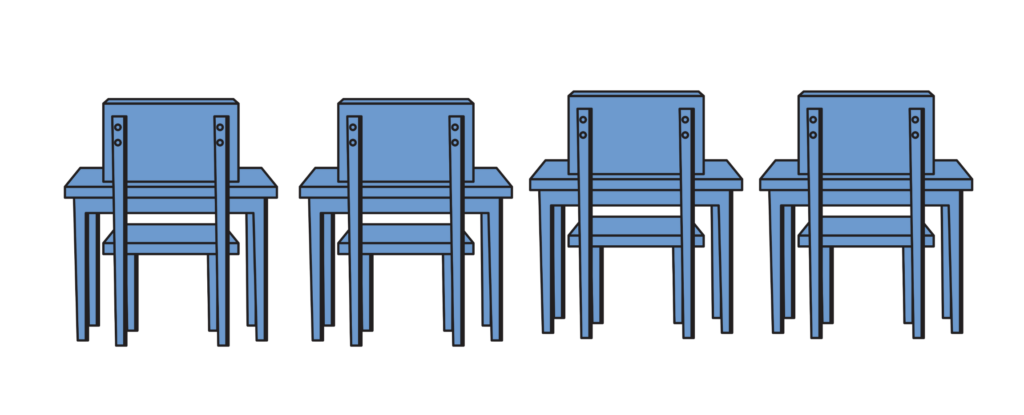As teachers, we know that the physical environment of a classroom can have a significant impact on how students engage with the material and each other. From the color of the walls to the lighting and temperature, every aspect of the room can contribute to a student’s ability to feel comfortable and stay focused. Have you considered how the furniture placement in your classroom can either reinforce or distract from the specific tasks we are asking students to do?
Research has shown that the way furniture is arranged in a classroom can significantly impact student behavior and learning outcomes (Granito & Santana, 2016; Parks, Corno & Cozzone, 2017). By strategically positioning desks, chairs, and other pieces of furniture, we can create an environment that promotes collaboration, active engagement, and independent thinking. I know many teachers reading this don’t have flexible furniture. They may even have my least favorite furniture item: the single desks with the chairs attached. Education is one “make it work” moment after another. The formations I describe below can be created by arranging single desks, two-seater desks, and other furniture items together.
When I coach teachers using the station rotation model that combines individual and collaborative learning activities both online and offline, we talk about how to arrange the furniture in the room to communicate the type of task students are doing. For example, we don’t want to create table groups where students are facing each other for an individual task that requires focus and concentration. When students are facing one another, the subtle message is that conversation and interactions are encouraged. This can result in students chatting and distracting each other when they should be engaged in a quiet individual task.
U-Shaped Desks for Teacher-led Station
When a teacher is leading small group instruction at their teacher-led station in a rotation it is helpful to have desks set up in a U-shape facing the whiteboard. Setting up the desks in a u-shape positions all students to face the teacher and makes it easier for the teacher to interact with each student individually. Teachers can easily move around the U-shape to provide targeted instruction and support as needed.
The U-shape seating arrangement also provides easy visual access to the whiteboard or other teaching aids, which the teacher may be using during the differentiated small group lesson. The teacher can use the whiteboard to demonstrate concepts, model problem-solving techniques, or show visuals to support their instruction. Positioning all students facing the whiteboard ensures that everyone can see and follow along with the lesson.
If teachers are using their small group time to facilitate discussions, the U-shape seating arrangement encourages student participation. The students can all see one another, creating a sense of community within the small group. This can help to build relationships among students and promote positive group dynamics.
Rows for Independent Tasks
While there is evidence to suggest that group seating arrangements can be beneficial for promoting collaboration and social skills, there are situations where sitting in rows or a straight line can be useful, particularly when students are working on individual tasks that do not require interaction or collaboration.

When students are working independently, they often need a quiet, distraction-free environment where they can focus on their own work. Sitting in rows can minimize distraction and allow students to concentrate on the learning activity without being tempted to socialize or interact with others.
When students engage in an online task that is individual, teachers may want to consider positioning the desks facing away from their teacher-led station. That way, the students’ screens are visible to the teacher if they want to quickly scan the room to ensure students are on-task and working in the assigned online environment.
Table Groups for Collaboration
Sitting in a group with others fosters communication and collaboration around shared tasks. When students are seated in groups, they are able to easily share ideas with their peers. This can help to promote collaboration and encourage students to work together to achieve a common goal. By working together, students are able to pool their knowledge and resources, which can lead to deeper understanding and more effective problem-solving.
In addition, group seating arrangements can help to build social skills and develop interpersonal relationships among students. When students work in groups, they are able to interact with one another on a regular basis, which can help to break down social barriers and create a sense of community within the classroom. This can lead to greater engagement and motivation, as students feel a sense of belonging and connection to their peers.
Group seating can also encourage students to take on different roles within the group, such as facilitator, note-taker, or questioner. This can help to build important leadership and communication skills, as well as promote positive group dynamics.
Arranging the Furniture in Your Classroom with Intention
In the station rotation model, students are often required to work independently or in small groups, moving between various learning stations throughout the classroom. By arranging the furniture in a way that promotes focus and engagement, teachers can help students to stay on task and remain engaged in their learning, even when working independently.
For example, if students are working at a computer station, arranging the desks in a way that minimizes distractions and provides a clear line of sight to the computer screen can help students to stay focused on their work. Similarly, arranging small group workstations in a way that fosters collaboration and communication can help to promote engagement and positive group dynamics.
Arranging furniture to maximize focus and engagement creates a classroom environment that supports self-directed learning, fosters engagement and motivation, and promotes positive learning outcomes. By taking the time to consider the needs of their students and their learning objectives, teachers can create a classroom environment that is conducive to student success. And, if the prospect of moving furniture feels daunting, see if you can enlist your students to help!
Want to learn more about the station rotation model? Check out my mini-course.





No responses yet